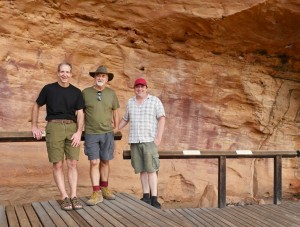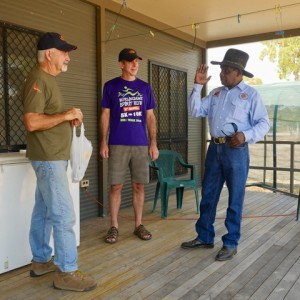 ICAN had the pleasure of hosting Professor Jerry Buckland from the Canadian University of Winnipeg last month. Professor Buckland stopped in Cairns as part of an international study tour of Australia and New Zealand, exploring developments in Financial Inclusion and Indigenous Natural Resource Partnerships. ICAN CEO Aaron Davis and Director Bob Frazer – CEO of Cape York Natural Resource Management took the Professor on a four-day tour of Cape York to meet with the Wujal Wujal Aboriginal Shire Council, Laura Rangers and David Claudie, CEO of the Chuulangun Aborignal Corporation near Lockhart River.
ICAN had the pleasure of hosting Professor Jerry Buckland from the Canadian University of Winnipeg last month. Professor Buckland stopped in Cairns as part of an international study tour of Australia and New Zealand, exploring developments in Financial Inclusion and Indigenous Natural Resource Partnerships. ICAN CEO Aaron Davis and Director Bob Frazer – CEO of Cape York Natural Resource Management took the Professor on a four-day tour of Cape York to meet with the Wujal Wujal Aboriginal Shire Council, Laura Rangers and David Claudie, CEO of the Chuulangun Aborignal Corporation near Lockhart River.
Aaron caught up with Jerry after their Cape York tour to get his thoughts and learnings from the journey so far:
What are some of the differences or similarities between how Canada and Australia each approach Financial Literacy and methods for inclusion?
From what I have observed, I am struck by two major differences in the approach to financial literacy and inclusion in Canada and Australia: the level of integration in the model and the level of collaboration among stakeholders.
First, I think that financial literacy (or financial capability) is more closely integrated with financial inclusion in Australia as compared with Canada. It seems to be well understood in Australia that literacy is one piece, albeit an important one, within a bigger approach to engagement with vulnerable people that includes recognition that institutions for inclusion matter. In Australia it seems to be broadly accepted that for improved financial well-being what is needed is improved literacy and better institutions such as appropriate and safe bank products. In Canada this more integrated understanding is accepted within certain sectors of civil society, but not widely embraced by the state or the banking sector. There are some elements in government and banking, particularly certain credit unions, who would embrace this more holistic approach. The Australian Financial Inclusion Action Plan is a very recent and tangible example of this. I am not aware of a similar plan in Canada.
A second major difference, and alluded to above, is the greater harmony among various stakeholders working for financial well-being in Australia as compared with Canada. Again the Financial Inclusion Action Plans is a tangible example of this. It includes a broad cross-section of stakeholders including from the state, civil society and banking sectors. And these stakeholders seem to agree that what is required is a comprehensive approach that includes financial literacy and inclusion to enable vulnerable people’s financial well-being. In Canada the concept of financial empowerment has gained considerable traction among civil society and seems to have attracted some limited support from the state and banking sectors. However, the state and industry continue to look at financial well-being primarily through the financial literacy lens, and thus a tension among stakeholders persists.
What did you think about ICAN’s Yarnin’ Money program?
ICAN’s Yarnin’ Money is very impressive and I would like to learn more about it. As I understand it the methodology focuses on facilitation, dialogue, photos, and narrative rather than teaching and presentation. In Canada I think that there is a growing realization that the classroom presentation may have a role in some cases, but generally speaking it does not affect people emotively, and therefore will likely not empower or motivate them. I was impressed when Eddie shared that the program begins with his honest sharing about some of his own financial struggles in the past. To learn that the facilitator has struggled with money in the past, I think, would be very empowering for participants who might feel ashamed or embarrassed about their own financial problems. Encouraging participants to share their stories, to use photos to represent a financial situation, to use of the timeline to ‘make sense of the world’, and to carefully and gently facilitate the group to keep it focused on topic, are all impressive components of the approach. I was particularly struck when Eddie talked about the ‘sad stories’ that participants share and how these difficult stories about finances can be the foundation for better group dynamics and important learning.
What are you planning to do with your learnings from Australia and New Zealand?
I think that there are many important things happening in Australia with respect to financial inclusion that we in Canada could benefit from. I hope to share what I’ve learned with people in Canada and I hope that I can encourage more interaction between our two countries. One tangible thing I plan to do is to use material that I have collected here in Australia in a book that I am working on, entitled Financialization and Human Development, which studies how money is increasingly moving to the centre of how we think of human development. I plan to include discussions of: ICAN’s Yarnin’ Money, the ‘Australian model’ of financial inclusion [including reference to the Financial Inclusion Action Plans], Commonwealth Bank’ Indigenous Customer Assistance Line (ICAL), and Good Shepherd Micro Finance’s NILS and Good Money Store.
A second goal I have is to encourage more interaction between Canadians and Australians engaged in financial inclusion work. This is challenging because of the distance between our countries and the associated travel costs. One Canadian venue for this interaction is the Asset Building Learning Exchange (ABLE) that happens once every two years and will take place in the fall 2017. It would be great to have some Australians present at this event and so we need to investigate funding sources for this. Finally, it would be very helpful to get some Canadians from civil society, banks, and government to visit various organizations and learn about these projects first hand. This might be most transformative for Canadian bankers.
 What was the highlight of your stay in North Queensland?
What was the highlight of your stay in North Queensland?
Learning about ICAN and the Cape York Natural Resource Management Inc. and visiting Cairns and the Cape York area were highlights of my trip to Australia. But the greatest highlight was making new friends and colleagues with people with common interests and experiences who are half-a-world-away. I was blown away by the warmth, kindness, and generosity of the folks that I met and interacted with in Cairns and Cape York. I felt as if I had come home!
Do you see possibilities for information sharing between Canada and Australia in the future?
Absolutely, information sharing would be very beneficial, and I wonder how can we foster this? We need to get more people visiting projects in the ‘other’ country (i.e., Can to Aus; Aus to Can). We need funds to enable this. I wonder if there are some electronic mechanisms we can put in place to promote mutual learning. That might make people realize the mutual benefits from the interaction.
*****
The ICAN family would like to thank Jerry for including us on his tour and Michelle Crawford for the connection. We look forward to exploring ways to work with Jerry on building an international community of best practice.